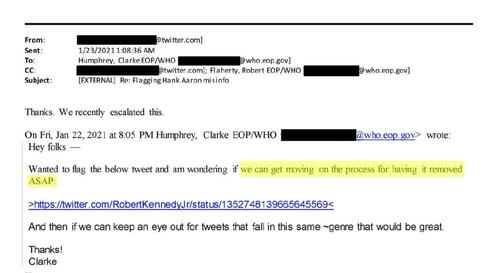tablet | My
fellow citizens, meet the Cybersecurity Infrastructure Security
Agency—better known as CISA—a government acronym with the same word in
it twice in case you wondered about its mission. This agency was created
in the waning days of the Obama administration, supposedly to protect
our digital infrastructure against cyberattacks from computer viruses
and nefarious foreign actors. But less than one year into their
existence, CISA decided that their remit also should include protecting
our “cognitive infrastructure” from various threats.
“Cognitive infrastructure” is the actual phrase used by current CISA head Jen Easterly, who formerly worked at Tailored Access Operations, a top secret cyber warfare unit at the National Security Agency. It refers to the thoughts inside your head, which is precisely what the government’s counter-disinformation apparatus, headed by people like Easterly, are attempting to control. Naturally, these thoughts need to be protected from bad ideas, such as any ideas that the people at CISA or their government partners do not like.
In
early 2017, citing the threat from foreign disinformation, the
Department of Homeland Security unilaterally declared federal control
over the country’s election infrastructure, which had previously been
administered at the local level. Not long after that, CISA, which is a
subagency of the DHS, established its own authority over the cognitive
infrastructure by becoming the central hub coordinating the government’s
information control activities. This pattern was repeated in several
other government agencies around the same time (there are currently a
dozen federal agencies named among the defendants in our suit).
So, what exactly has the government been doing to protect our cognitive infrastructure? Perhaps the best way to wrap your head around the actual operations of the new American censorship leviathan is to consider the vivid analogy offered by our brilliant attorney, John Sauer, in the introduction of our brief for the injunction. This is worth quoting at length:
Suppose that the Trump White House, backed by Republicans controlling both Houses of Congress, publicly demanded that all libraries in the United States burn books criticizing the President, and the President made statements implying that the libraries would face ruinous legal consequences if they did not comply, while senior White House officials privately badgered the libraries for detailed lists and reports of such books that they had burned and the libraries, after months of such pressure, complied with those demands and burned the books.
Suppose that, after four years of pressure from senior congressional staffers in secret meetings threatening the libraries with adverse legislation if they did not cooperate, the FBI started sending all libraries in the United States detailed lists of the books the FBI wanted to burn, requesting that the libraries report back to the FBI by identifying the books that they burned, and the libraries complied by burning about half of those books.
Suppose that a federal national security agency teamed up with private research institutions, backed by enormous resources and federal funding, to establish a mass-surveillance and mass-censorship program that uses sophisticated techniques to review hundreds of millions of American citizens’ electronic communications in real time, and works closely with tech platforms to covertly censor millions of them.
The
first two hypotheticals are directly analogous to the facts of this
case. The third, meanwhile, is not a hypothetical at all; it is a
description of the Election Integrity Partnership and Virality Project.
The
censorship activities of the nation’s largest law enforcement agency,
which it terms “information warfare,” have turned the FBI, in the words
of whistleblower Steve Friend, into an “intelligence agency with law
enforcement powers.” But there is no “information warfare” exception to
the constitutional right of free speech. Which other federal agencies
are involved in censorship? Besides the ones you might suspect—the DOJ,
NIH, CDC, Surgeon General, and the State Department—our case has also
uncovered censorship activities by the Department of the Treasury (don’t
criticize the feds’ monetary policies), and yes, my friends, even the Census Bureau (don’t ask).
In
prior precedent-setting cases on censorship, the Supreme Court
clarified that the right of free speech guaranteed by the Constitution
exists not just for the person speaking but for the listener as well: We
all have the right to hear both sides of debated issues to make
informed judgments. Thus all Americans have been harmed by the
government’s censorship leviathan, not just those who happen to post
opinions or share information on social media.
The judge presiding over the case, Terry Dougherty, asked on Friday in court if anyone had read George Orwell’s 1984 and whether they remembered the Ministry of Truth. “It’s relevant here,” he added. It is indeed time to slay the government’s Ministry of Truth. I hope that our efforts in Missouri v. Biden prove to be a crucial first step in this project to restore our constitutional rights.


